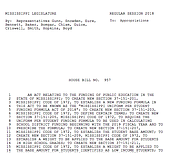Rep. Bryant Clark, D-Pickens, argued that House Speaker Philip Gunn’s new funding formula proposal is not equitable during debate on Jan. 17. Photo by Stephen Wilson.
JACKSON — The Mississippi House Education Chairman, Rep. Richard Bennett, R-Long Beach, repeatedly told House members that the Mississippi Adequate Education Program is too complicated to understand and not reliable for school districts last week.
"I do not want to pretend to understand it," Bennett said when answering questions about MAEP last week.
The new Republican funding formula proposal, called the Mississippi Uniform Per Student Funding Formula, or the "UPS" formula for short, at full funding and implementation calls for nearly $200 million less than MAEP currently does. MAEP has only been fully funded twice, and in the current fiscal year is underfunded by well over $400 million.
Authors of MAEP argue that the formula is only unreliable because it is not fully funded. Sen. Hob Bryan, D-Amory, points out that MAEP is designed to inform lawmakers how much money "adequate" school districts actually need to operate.
"(MAEP) provides an objective amount of money that the public schools need ... to operate the programs and to educate the students that they are being required to provide (education for)," Bryan said last week. "The fact that the Legislature doesn't fund it does not change the fact that that's how much money they need."
When pressed on the loss in hundreds of millions of dollars for full funding in the formula, Bennett told reporters that MAEP was "unrealistic," pointing out that one of the two years when MAEP was funded was only when the federal government covered Mississippi's Medicaid costs after Katrina, freeing up enough money to fund MAEP fully.
Realistic or not, the UPS formula could become the new reality for Mississippi school districts. Here's what is in the bill and what was left out.
What's Inside House Bill 957
Weights: The UPS plan scraps the formula prescribed in MAEP to calculate the base student cost every four years, using inflation measures. Rep. Bryant Clark, D-Pickens, noted this in debate on Wednesday.
"There's nothing in this bill that will ensure that this body will come back at any time in the future and make an adjustment to the base student cost," he said.
Bennett agreed that the base student amount will need to re-evaluated and committed to looking at it.
"I can guarantee you that I will look at it," Bennett said.
Instead, UPS sets a base amount at $4,800 per student and adds weights for each student based on needs; that includes high-school students, low-income and English language learners, special education and students in rural districts. High-school students get a higher base amount, starting at $6,240. Those additional funds are supposed to be used for college and career programs from AP courses to vocational-tech programs.
The weight for low-income students is currently based on districts that receive free and reduced lunch from the federal government. That number is not an accurate measure of students in poverty, however, because the Food and Drug Administration now allows districts with just 40 percent of their students in poverty to count their whole district as free and reduced lunch.
The proposed formula uses Census poverty rates instead, but some Democrats pointed out during debate that data are often underreported and will also not discount all of the students in the school district zone that attend private schools, lowering some districts' poverty rates, despite their high number of low-income students.
"I have been having conversations with the Census folks and what we're finding is that a large amount of people are not counted," Rep. John Hines, D-Greenville, said on the House floor last week. He offered an amendment to keep the low-income weight at the free and reduced lunch number that MAEP currently uses.
The "UPS" formula uses the Small Area Income and Poverty Estimate, which vary widely from district to district.
For example, 2016 SAIPE poverty rates show the Clinton School District at 17.9 percent, while Hinds County School District is at 16.2 percent and Jackson Public Schools is at 35 percent.
English-language learners are counted based on a district's evaluation if a student is entitled to bilingual services under federal law. Gifted students receive a weight in this formula, and these students are singled out in every district in the state. They account for only 7 percent of students, EdBuild's report shows. Special-education students will receive funds through tiered weights, depending on their needs. For example, a student who is deaf receives a 170-percent weight at Tier 3, while a student with a developmental delay receives a 60-percent weight at Tier 1. Students in districts with fewer than four students per square mile receive more funds as a "sparse" district.
Average Daily Membership: The shift to average daily membership, which counts student enrollment several times a year, is a change that many lawmakers wanted to make to MAEP. School districts advocated for this change in MAEP long before EdBuild came to town because counting enrollment would give a more accurate picture of how many students are in a district, instead of counting attendance on a specific day of each year.
The UPS formula involves the state auditor to ensure that districts are reporting accurate numbers, and if districts report numbers wildly different than the auditor finds, they will be funded based on the auditor's count, not their own.
Accountability, Transparency: House Bill 957 directs the Mississippi Department of Education to study how much money a school district must provide for education funding. MDE must edit its accounting manual so school districts report data-based on the new weights in the UPS formula. The department must develop a fiscal transparency system that is public and enables districts to compare funds and use of funds to other peer districts. MDE is also directed to create a financial rating model that rates the financial health of districts.
Committees: House Bill 957 creates three committees. The first committee is made entirely of lawmakers to evaluate the state accreditation standards and consider cutting certain regulations for the state's highest-performing districts and highest academic growth districts.
MDE is required to submit a report to this committee about the accreditation standards, particularly in regards to student-teacher ratios and teacher salaries.
Rep. Clark objected to a part of the bill that allows lawmakers to collect a per diem for travel expenses and meetings. His amendment to remove the language lost.
The UPS bill also creates a special-education committee to evaluate whether the weights set in the new formula are correct. The State Board of Education must create the committee, which in turn, must prepare a report by December 2018 for the legislative education and appropriations committees. The state superintendent is supposed to create an early-learning continuum study committee to look at expanding pre-kindergarten statewide and possibly funding it through the new formula.
That committee is also required to submit a report before December 2018.
Implementation: The UPS formula is scheduled to phase in over the next seven fiscal years. The State Board of Education and the Mississippi Charter School Authorizer Board must evaluate the formula before 2021. The legislation includes two years of a "hold harmless" period for school districts that are going to lose funding under the new proposal.
Thirty-five districts will receive fewer funds than they are this year from MAEP when the UPS formula is fully funded in approximated amounts ranging from $8,000 for Philadelphia schools to more than $2 million for Moss Point schools.
Chairman Bennett repeatedly stressed that the bill will not go into effect for two years, giving lawmakers time to address several concerns from the low-income poverty rate measure to the 27 Percent Rule. When challenged on things that could use fixing, he said, "that's why it's not going into effect for two years." He asked the House to pass a "clean" bill, rejecting all 17 of the Democratic amendments.
HB 957 does not address the rest of the state's 143 school districts that could eventually gain funds in the new proposal, implying that districts slotted to receive more could begin receiving more as early as this July—depending on how much the Legislature chooses to appropriate. School districts that lose students will continue to lose funds, however, as they do currently under MAEP. If and when fully funded, UPS will provide nearly $200 million less to schools than MAEP would fully funded.
What Is Left Out of HB 957:
Speaker Gunn left out two key components of EdBuild's recommendations, which Democrats argued on the House floor last week make the new proposed formula inequitable. EdBuild recommended that the state eliminate a rule, written into MAEP, that requires districts to only contribute 27 percent of the total cost to fund their schools. This rule is inequitable because the required minimum amount of millage per school district, 28 mills, produces a drastically different number depending on a school district's property values.
Property-wealthy school districts get to keep the rest of the 28-mill levy, despite being able to pay way more into their total school funding than other districts. Pascagoula School District benefits the most from this rule, keeping more than $17 million in funds in fiscal-year 2017, data from EdBuild's recommendations show. The rule hurts property-poor school districts throughout the state while essentially giving a tax break to school districts and communities that can afford to foot more of the bill to fund their schools than they are.
House Minority Whip David Baria, D-Bay St. Louis, introduced an amendment to phase out the rule.
"If we don't do something on the 27 percent rule now, how likely is it that we will come back and ever do anything?" he said. "... Folks this is your chance to do equity right here."
Chairman Bennett pointed out earlier in debate that at full implementation, UPS will be a $164-million increase for low-income children in the state.
Democrats felt that the bill lacked equity in other ways, however.
"The most important thing about any funding formula in Mississippi is the equity," Rep. Clark said on the floor. "... The reason that we have MAEP is not because this body was jumping up and down to fund education. It was the threat of a lawsuit and that formula had to have equity."
Eliminating the rule would generate nearly $120 million in state revenue that could be rolled into a new formula, the EdBuild recommendations show.
The "27 Percent Rule" stayed in HB 957, however, and Gunn committed to looking at the measure during the two-year study period but said he believed eliminating the rule might lead to districts having to raise taxes.
Rep. Jarvis Dortch, D-Jackson, asked how not eliminating the 27 Percent Rule was equitable. "One of the things (EdBuild) pointed out was that a district like Madison County was being subsidized by the state, to the tune of $13 million, that we were providing them with too much money and now with this plan, we're going to provide them with an additional $1 million in state funding—is that not buying us a federal lawsuit?" Dortch asked.
Bennett said anyone can file a lawsuit but that taking away the "27 Percent Rule" would hurt several districts. "I think it's (too) drastic of a cut to penalize a community that have worked to build the economy in their town, and now all of a sudden we're going to penalize them," he said. "I do think it needs to be looked at ...."
EdBuild also suggests allowing districts to raise their millage cap of 55 mills, which is currently written into state law. The cap, EdBuild noted in their recommendations, "is one important mechanism for ensuring equity in a state formula, because it prevents the tax burden in districts from rising too much in relation to other districts' tax rates," it can also mean in years with cuts to education funding from the state, a district could "be left with no choice but to cut important programs or positions."
The new formula proposal is now in the Senate and has not been referred to a committee for consideration by press time.
Email state reporter Arielle Dreher at [email protected].




